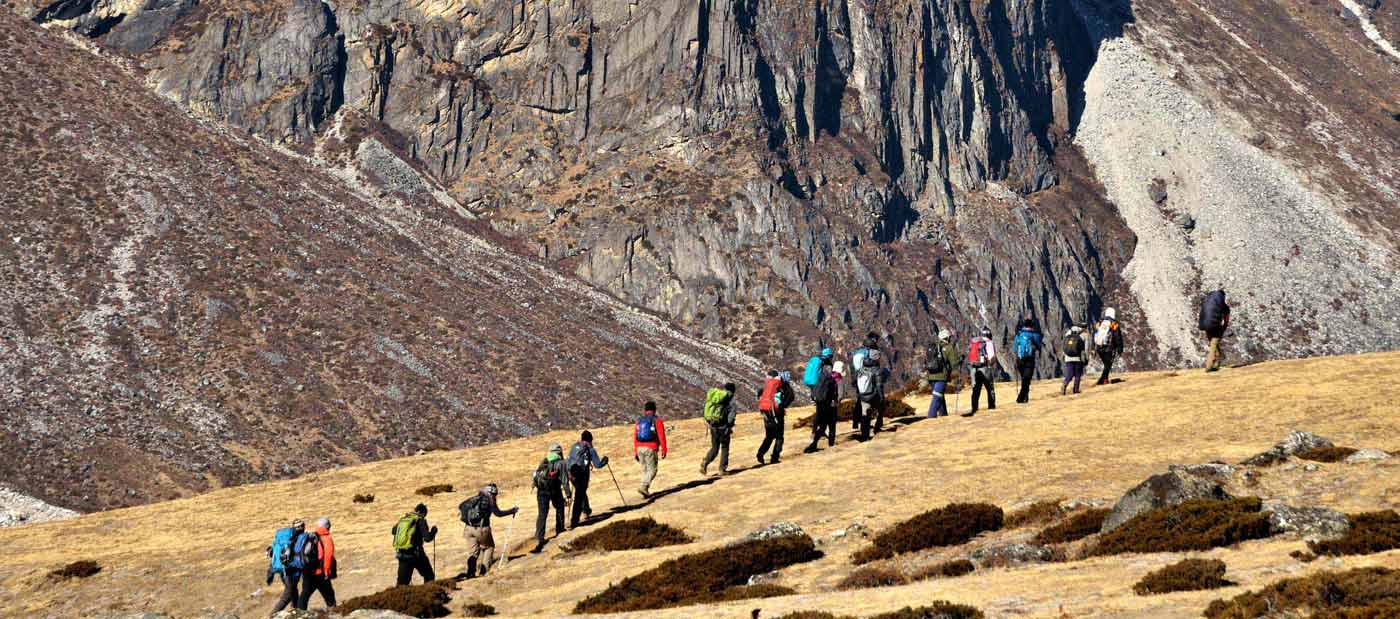How fit do I have to be to do a trek?
Whilst you do not need to be super-fit, you need to be fit enough to comfortably walk for 5-6 hours per day in the mountains on reasonable trails both uphill and downhill. This would definitely entail walking for around an hour at least every day to get fit. If you can spend some time in the gym it would help. Walking up and down stairs with a light day pack (5 kg) can definitely boost fitness.
What is a typical group? Will I fit in?
Groups range in size from 8 up to 12, and typically comprise a range of nationalities and experience. We have also had a group upto 14! So far, all of our groups have got along very well. One of the attractions of such a trip is the chance to meet people with different backgrounds and personalities.
Do I need to buy special equipment?
Usually our clients simply bring their existing clothing and equipment and if necessary supplement this with some extra items purchased cheaply in Kathmandu.
I am a single trekker. How does this work?
Normally single trekkers have no problems fitting in with a group. Normally single trekkers share rooms or lodges with other trekkers of the same sex, but if we have an odd-number we ensure that a room or lodge is organised accordingly.
Will I be able to deal with the high altitude?
Our itineraries are designed so that our clients ascend at a sensible and safe rate. The effects of altitude are felt by everyone, even the guides and Sherpas, but most people find that gentle acclimatisation allows them to reach their high point without any problems. We will be monitoring this closely on the trek and in the event of any problems we will ensure that there is no compromise on safety.
How difficult are the treks ?
The difficulty of our treks depends on where you want to trek and how long you want to go. The shorter Treks tend to be easier while the longer ones require some greater levels of physical fitness. Be prepared for some steep trails leading to amazing views. The pace at which you hike is up to you. We have friendly and dependable porters to assist you with your personal gear so you just carry a day pack.
What are the Tea Houses like?
Tea houses are a way of life for almost all trekkers. They are the combination of guest house, restaurant, and social hang out. Our many years of experience along these routes have helped us find the friendliest, cleanest, and most enjoyable tea houses with the best views. For an interesing article on tea house trekking in Nepal do visit http://www.greathimalayatrails.com/teahouse-trekking-nepal/
What is the accomodation at the tea houses?
Private rooms are available in most tea houses except for those at very high altitudes. Most bathrooms are shared but in some of the nicer lodges we have attached bathrooms with running water. Usually hot showers will be available every evening.
Where do we eat our meals ?
If you are on a tea house trek you will eat breakfast and dinner at your tea house. We will stop for lunch at one of the various trail side restaurants. And snacks are always easy to find at tea stalls including tea and coffee.
What type of food is served on the trek?
Almost every tea house serves the traditional Nepali meal Dal Bhat (rice and curried lentils). All tea houses we stay at have a variety of different foods on the menu including noodles, rice, potatoes, vegetables and soup. Some have Nepali versions of western food such as pizza, lasagnia, pasta etc. Sodas and beer are available at most of the tea houses and of course tea and coffee is served everywhere.
Where do we get water during the trip ?
It is our suggestion that in order to save money, trekkers carry iodine tablets or lugols solution with them so that they can purify the water every day. Though tea houses will have bottled mineral water available it is likely to get expensive as one goes higher up. Iodine is available in Kathmandu.
What clothes should I bring ?
Please see the Equipment checklist on this site.
What type of shoes or boots should I wear ?
The proper foot wear depends on the trek. Shorter treks can be done in comfortable running shoes while longer ones require sturdy but light weight hiking boots. Shoes and boots are best purchased before your arrival for the trek with proper break in.
What will the weather be like ?
Weather effects everything in the Himalaya and trekking is no exception. Sudden rain storms or snow flurries are always a possibility at higher altitudes. The weather during the trekking season is somewhat more stable. We pay close attention to weather reports during the trekking season. Traditionally post monsoon months offer clear sunny weather Mid October to early December in Nepal.
How should I give my equipment to the porter?
Ideally the gear should be given to the porter in a duffle bag locked and this willl be returned to the client in the evening. As you may not be able to access the duffle bag during the day please carry the essentials like water, jacket, camera, sweets etc in your daypack.
